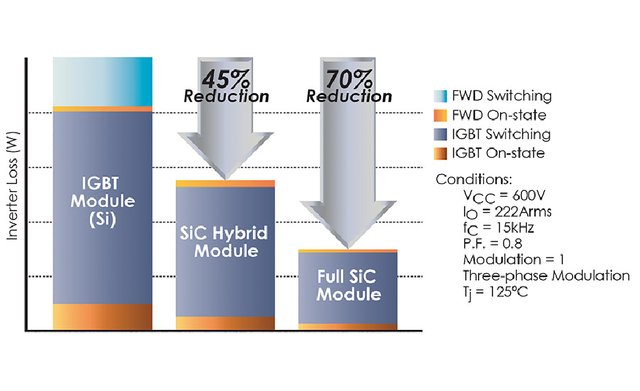Part II: In-depth application of silicon carbide (SiC) power devices in new energy vehicles
3. Application of third-generation semiconductor power devices in the automotive industry
Electric vehicle drive system
In the drive system of electric vehicles, third-generation semiconductor power devices can be applied to key links such as motor drivers, DC/DC converters, and chargers. Efficient SiC or GaN devices help to increase the output power of motor drivers, reduce volume, and reduce heat loss, thereby achieving higher driving range and faster charging speed.
Automobile power electronics system
Automobile power electronics systems, such as battery management systems (BMS) and energy recovery systems (ERS), can benefit from the advantages of third-generation semiconductor power devices. For example, the use of efficient GaN devices in BMS can reduce switching losses, improve battery charging and discharging efficiency, and extend battery life.
Automobile intelligent driving system
With the continuous development of automotive intelligent driving technology, such as autonomous driving and vehicle networking, the demand for high-speed and efficient semiconductor devices is also growing. The application of third-generation semiconductor power devices in key links such as radar, LiDAR, and image processing can achieve faster data processing speed, lower energy consumption, and higher reliability.
Automotive electronic systems
Automotive electronic systems, such as in-vehicle infotainment systems, instrument panels, climate control systems, etc., can also benefit from the advantages of third-generation semiconductor power devices. For example, in in-vehicle infotainment systems, the use of GaN power amplifiers can achieve higher output power and a wider frequency range, improving the quality of audio and video.
New energy vehicle charging infrastructure
With the booming new energy vehicle market, the construction of charging infrastructure has also become critical. The application of third-generation semiconductor power devices in key components such as DC/DC converters and DC/AC inverters in charging piles can help improve charging efficiency, reduce energy consumption, and shorten charging time, laying the foundation for the popularization of new energy vehicles.
4. Silicon carbide semiconductor industry chain
The silicon carbide semiconductor industry chain mainly includes "silicon carbide high-purity powder → single crystal substrate → epitaxial wafer → power device → module packaging → terminal application" and other links.
4.1 Silicon carbide high-purity powder
Silicon carbide high-purity powder is the raw material for growing silicon carbide single crystals using the PVT method. The purity of its product directly affects the growth quality and electrical properties of silicon carbide single crystals. There are many ways to synthesize silicon carbide powder, mainly solid phase method, liquid phase method and gas phase method. Among them, the solid phase method includes carbon thermal reduction method, self-propagating high temperature synthesis method and mechanical crushing method; the liquid phase method includes sol-gel method and polymer thermal decomposition method; the gas phase method includes chemical vapor deposition method, plasma method and laser induction method.
4.2 Single crystal substrate
The single crystal substrate is the supporting material, conductive material and epitaxial growth substrate of the semiconductor. The key step in producing silicon carbide single crystal substrates is the growth of single crystals, which is also the main technical difficulty in the application of silicon carbide semiconductor materials and is a technology-intensive and capital-intensive link in the industrial chain. At present, the methods for growing SiC single crystals include physical vapor transport (PVT), liquid phase method (LPE), high temperature chemical vapor deposition (HT-CVD), etc. Comparison table of silicon carbide single crystal growth methods
4.3 Epitaxial wafer
Silicon carbide epitaxial wafer refers to a silicon carbide wafer with a single crystal thin film (epitaxial layer) with certain requirements and the same crystal orientation as the substrate grown on a silicon carbide substrate. In practical applications, wide bandgap semiconductor devices are almost all made on the epitaxial layer, and the silicon carbide wafer itself is only used as a substrate, including the substrate of the GaN epitaxial layer. At present, there are many methods for preparing SiC thin films on silicon carbide single crystal substrates, such as chemical vapor deposition (CVD), liquid phase deposition (LPE), sublimation, sputtering, and MBE. Among them, CVD is the main method for preparing high-quality silicon carbide crystal thin film materials and devices.
4.4 Power devices
Wide bandgap power devices made of silicon carbide materials have the characteristics of high temperature resistance, high frequency, and high efficiency. According to the working form of the device, SiC power devices mainly include power diodes and power switch tubes. SiC power devices, like silicon-based power devices, are processed using microelectronics technology. From the perspective of silicon carbide crystal materials, 4H-SiC and 6H-SiC are most widely used in the semiconductor field, among which 4H-SiC is mainly used to prepare high-frequency, high-temperature, and high-power devices, while 6H-SiC is mainly used to produce power devices in the optoelectronic field.
4.5 Module packaging
Module packaging can optimize the performance and reliability of silicon carbide power devices during use, and can flexibly combine power devices with different application solutions. At present, the packaging types of related power devices in the mass production stage basically follow silicon power devices. The commonly used packaging types of silicon carbide diodes are mainly TO220, and the commonly used packaging types of silicon carbide MOSFETs are mainly TO247-3. A few use new packaging methods such as TO247-4 and D2PAK.
4.6 Terminal applications
Silicon carbide devices have the advantages of small size, high power, high frequency, low energy consumption, low loss, and high voltage resistance. The current main application areas: various power supplies and servers, photovoltaic inverters, wind power inverters, on-board chargers for new energy vehicles, motor drive systems, DC charging piles, variable frequency air conditioners, rail transit, military industry, etc.

6. Future Outlook
The application of third-generation semiconductor power devices in the automotive industry still has a lot of room for development. With the continuous optimization of SiC and GaN material manufacturing processes and the reduction of costs, these high-performance semiconductor devices will be widely used in more automotive electronics fields.
In addition, as the functions of on-board electronic systems become more and more numerous and the integration becomes higher and higher, the performance requirements for semiconductor devices will continue to increase. In the future, third-generation semiconductor power devices are expected to make greater breakthroughs in higher frequencies, higher temperatures, and higher powers, further promoting the innovative development of the automotive industry.
In short, third-generation semiconductor power devices are increasingly widely used in the automotive industry with their excellent performance such as high energy efficiency, high frequency, and high temperature. From electric vehicle drive systems to intelligent driving systems, from automotive electronic systems to new energy vehicle charging infrastructure, third-generation semiconductor power devices are helping the automotive industry move towards a higher technical level.


